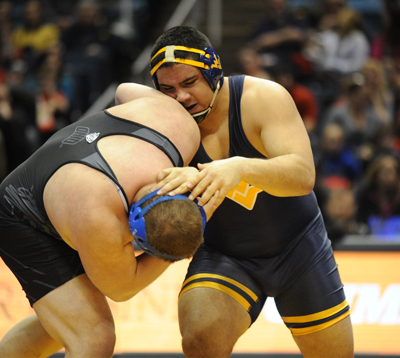If you want to model yourself on high level grapplers that combine technique, strength , speed, agility, conditioning then look at collegiate wrestlers.
Here is the West Virginia University Tech Golden Bear Wrestling Strength and Conditioning Program.
The “off-season” program that follows is a basic strength-building program based on fundamental exercises that have provided tried and true results for athletes. The program is designed to be followed easily, build strength, prevent injuries, and build work capacity over time. Do not let the lack of fancy bells and whistles fool you, as this training protocol will allow you to develop the brutal kind of strength, both physical and mental, that wins college wrestling matches.
Basic Philosophy and Training Rules to Keep in Mind
Before you skip to the actual workouts themselves, please read, then re-read the accompanying points so that you have an understanding of the what, why, and how of what you will be doing in this program. You don’t need to turn into a exercise scientist to develop strength, but a little knowledge can go a long way toward making the program effective.

• This is not a bodybuilding program. There will be no “Back and bis” or “Chest and tris” days. Generally the entire body will be stressed in one manner or another at every training session. You will never have a day where you go in and “blast your biceps”.
• The great focus of this program will be on exercises that build and strengthen your “posterior chain”. These are the muscles than run up your back from your calves to you neck, muscles that are often neglected by “body building” type programs, and which are crucial to injury prevention and athletic performance.
• You are never to “max out” with a true heavy single. We are training to get stronger, not break weight-lifting records. Finding a true max in many exercises isn’t worth the danger you subject yourself to.
• When building and testing your strength always leave a rep or two in the chamber. The last rep should be difficult, but it should move at the same speed as the other reps, it should be smooth (not wobbling or shaking) and you should feel that if push came to shove you could do one or two more.
• We never train to failure. Stop your set before your form breaks down. Training to failure actually negatively impacts strength, and it slows recovery down. Plus, mentally you will be able to know that you have a string of successes under your belt rather than a string of failures, which should help you remain confident.
• Use a training log. Keep track of the exercises, sets, reps, and weights you use, or the number of sprints you do, or the technique drills you execute when you train. You cannot accurately judge progress, or develop confidence, if you don’t have hard numbers to base decisions on. All the greatest American wrestlers use a training journal, so you should too.
• When it comes to training more is not better. Better is better. Consistent, hard training, that forces you to push yourself, but not kill yourself, is far more effective in building the strength needed to succeed than the 2 hour a day, six- day-a-week programs some poorly informed people recommend.
• Use a bunch of warm-up sets. On your big exercises, the core ones we use in this program, take your time working up to your work sets. Use the bar, use smaller weights, and do a number of sets with reps a few less than your work sets (ie. When your work sets are sets of 5, do warm-ups with sets of 3), or do singles and doubles working on form as you build up. This will allow you to perfect technique and avoid injury while allowing you to perform better.
• Cardio work is done at the end of the workout. Some skipping and mobility stuff is fine as you warm-up, but save your energy for strength building, then deplete it with the cardio at the end of training. Do not waste your energy that could be used for strength building work by doing cardio before hand.
• Avoid long distance running at all costs. It does not mimic the kind of conditioning used in wrestling, it eats away at muscle tissue, and it wears away your knees. One or two times a week find a hill and sprint up it a number of times until you are tired, but not puking kind of tired. One time a week do some incline treadmill walking or elliptical trainer work for 20-30 minutes at the most.
• Intensity is defined as the percentage of your 1-rep “max”. Intensity is not a feeling, it is not being tired, or wiped out, or exhausted. If you are using 95% of your max, you’re working at 95% intensity. You might move the weight fast and easy, but you are using a high intensity level. Sometimes using a high intensity is “hard” and you struggle, but never forget it is defined as a % of your 1-rep max.
• You do not get stronger in the weight room, you get stronger when you rest and recover! Six days a week, two or three hours a day is not an effective way to build strength, but it is a great way to destroy it. Again, more is not better. Work out just enough to build strength.
• If your weights don’t consistently improve you are probably doing to much. Each week you should see some improvement in some, if not all, of your core lifts. If you start to stall, that means you are out training your recovery. More is not better, better is better.
• Learn to love the “de-load”! Every 4th week you are going to reduce the number of reps, sets, and exercises you do, as well as the intensity (use between 40% and 60%). These are important weeks to allow your body to recharge, reduce the stress, and give yourself a chance to improve. If you are going crazy during a de- load week, and feel the need during that week to want to kill it in the weight room, DO NOT give in to that desire. It means your testosterone is high and you’ll get better gains when you move into your next work cycle.
• The training is broken up into a number of 4-week mini-cycles, or blocks, of training. This is important to be aware of, because it will be the 4th week of each block that you de-load. Each training block will have specific sets and rep schemes for you to complete, and will build on the previous block in terms of volume.
• Technique is key. Learn to do the exercises correctly first. Don’t worry about the weight used, it will come in time. Perfect the technique and you will get strong quickly!
Training Structure
Block I
May 4th through May 31
Week 1 5/4-5/10 Week 2 5/11-5/1
Block II
June 1st through June 28th
Week 1 6/1-6/7 Week 2 6/8-6/14
Block III
June 29th through July 26th
Week 1 6/29-7/5 Week 2 7/6-7/12
Block IV (Note this is a 3 week block)
Training Blocks
Week 3 5/18-5/24
Week 3 6/15-6/21
Week 3 7/13-7/19
Week 4 5/25-5/31
Week 4 6/22-6/28
Week 4 7/20-7/26
July 27th through August 16th
Week 1 7/27-8/2 Week 2 8/3-8/9
Week 3 8/10-8/17
Loading Parameters (Sets and Reps) Some accessory exercises will use lower reps
Block I – Week 1- Week2– Week3– Week4–
Block II– Week 1- Week2– Week3– Week 4 –
Block III Week 1- Week2– Week3– Week 4 –
Block IV Week 1- Week2– Week3–
3 work sets of core lifts, 2 work sets of accessory lifts Work sets of core lifts 5 reps. Accessory lifts 6-8 reps Work sets of core lifts 3 reps. Accessory lifts 8-10 reps Work sets of core lifts 1-2 reps. Accessory lifts 10-12 reps
De-load: core lifts 3sets x 5 reps 40-60% of max, 2 easy sets of accessory work
4 work sets of core lifts, 3 work sets of accessory lifts Work sets of core lifts 5 reps. Accessory lifts 6-8 reps Work sets of core lifts 3 reps. Accessory lifts 8-10 reps Work sets of core lifts 1-2 reps. Accessory lifts 10-12 reps
De-load: core lifts 3sets x 5 reps 40-60% of max, 2 easy sets of accessory work
–
5 work sets of core lifts, 3 work sets of accessory lifts Work sets of core lifts 5 reps. Accessory lifts 6-8 reps Work sets of core lifts 3 reps. Accessory lifts 8-10 reps Work sets of core lifts 1-2 reps. Accessory lifts 10-12 reps
De-load: core lifts 3sets x 5 reps 40-60% of max, 2 easy sets of accessory work
–
5 work sets of core lifts, 4 work sets of accessory lifts Work sets of core lifts 5 reps. Accessory lifts 6-8 reps Work sets of core lifts 3 reps. Accessory lifts 8-10 reps Work sets of core lifts 1-2 reps. Accessory lifts 10-12 reps

Training Requirements
By now you have read the two-page philosophy and training rules section, which lays out what this program is, what it will emphasize, and the basic do’s and don’ts. As you read further these will be re-emphasized a number of times, and there will be additional information included. Please be sure to pay careful attention to the additional information that is included…you don’t need to be an exercise physiologist, but you do need to understand why this is structured the way it is, and the anticipated results.
Volume: (as defined for training): The total amount of work you do. It is computed by multiplying the number of sets x number of reps x the weight.
As you can see the blocks are broken down week-to-week, with repeating rep schemes and an increased number of sets from block to block. This is how we gradually increase your total training volume, and by extension your overall work capacity. The reason we don’t jump right into 5 sets is because most athletes can make gains using fewer sets (less total volume) early on. By slowly increasing the volume over time you can continue to coax strength gains from your body without having to drastically increase the workload. This is the concept of more is not better, better is better, in action. At some point, if you add sets, reps, and volume to early and quickly, you hit a point where you simply cannot continue to add to the total volume because of time and recovery issues. By controlling the volume you never hit that point of too much of a good thing.
• You will be required to train 3 or 4 times a week. Depending on your schedule, and what works best for you (schedule, training experience, recovery ability), you’ll need to choose either a 3-day program, or a 4-day program.
• You will be required to fit the 4 core lifts in over the course of either the 3-day or 4-day program.
• You must get all 4 of your core exercises completed in the week. You cannot, for example, miss squats in Week I and then double up on them in Week 2. Consistency is important.
• You want to add weight to your core exercises from block to block, if not week to week. It is self explanatory that as the number of reps goes down in each week the expectation is for you to use a heavier weight. But, it is important to remember that you want the weights used in Block II to be heavier than the weights used in Block I.
• There may be weeks that there are big jumps in strength, and some weeks where there might be little dips in strength, from time to time. Don’t sweat the small stuff like that. As long as your numbers are moving northward you are doing it right. This is why it is important to keep a training journal or log!

Core Lifts
Our “Core Lifts” are defined as the exercises that must be done EVERY week. The idea is that if you did just the core lifts, worked extremely hard at them, and followed the loading parameters you would become significantly stronger, and be better prepared to execute your athletic training.
By necessity these Core Lifts are the most physically taxing strength training exercises you can do. Anyone can do leg extensions or dumbbell fly exercises without taking too much out of themselves, but it takes real effort to squat, clean, deadlift, and bench press heavier and heavier weights, week after week, and training cycle after training cycle. Look at the athletes who consistently squat heavy, deadlift regularly, hit heavy cleans with great speed, and test themselves under the bench press time and again. Compare them to athletes you know who avoid the weight room, or are inconsistent with their efforts, and choose to focus on easier exercises. You can clearly see the rewards of the consistent hard work on the mat and in a singlet.
Squats
• Squats are the foundation of sport. All athletics require the muscles trained when squatting to be strong, injury resistant, and fully functional.
• Squatting is NOT bad for your knees. Squatting is actually good for your knees, as they build your hamstrings and posterior chain, balancing out the muscles around your knees. Muscle imbalances caused by a failure to regularly squat are often the cause of major knee injuries.
Cleans
• You can do full cleans or power cleans, but the motion is important.
• It teaches you how to fire explosively, and perform the triple extension (ankle,
knee, hip) in the correct order that is critical to so many athletic movements.
• If you are just learning, do each section of the progression for a week. Do not
worry about getting it learned the first time you do it, take your time! o The first week work on the starting pull.
o The second week work on the starting pull into the high pull. o The third week work on the full clean.
o The fourth week you should be able to do the clean with the squat.
• The same idea applies, use each week do one step and master it. You can even train it a couple of times a week since you are using light weights at first!

Deadlifting
• Everything gets strong when you deadlift. Back, hamstrings, traps, lats, glutes, abs.
• Most physically taxing of the lifts, because there is no “lowering” phase to start the lift. It is dead weight, hence the name.
• Focus on technique, just as you would any other exercise.
• It is important to keep your entire body tight throughout the lift.
Bench Press
• Why the bench press? Well, you are going to spend time on it anyway, we might as well make it important.
• It is the upper body version of the squat. A true test of upper body strength.
• We always bench press on Mondays? Why? Because it is National Bench Press
Day! If you love America and hate terrorists, then bench on Monday!
• Even though it is an upper body exercise, make sure you keep your entire body
tight! Drive the feet into the ground, squeeze the glutes, pinch the upper back
together.

Accessory Lifts
Accessory lifts are done to support the main Core Lifts. They are designed to do a
number of things:
• Strengthen muscles not hit as directly with the core lifts.
• Strengthen muscles involved in the core lifts so that the core lifts go up.
• Strengthen the weak links in the core lifts.
• Provide balance to antagonist muscle groups, this balance prevents injury.
o For example, benching builds muscle and strength in your chest and anterior deltoids. If the posterior deltoids and rhomboids (the muscles on the back of your shoulders and upper back) aren’t sufficiently strong enough, then the forces generated in athletic competition or training can injure your shoulders
o Huge quads and weak hamstrings are the harbinger of doom for knees! You great tremendous force without the antagonistic muscles to act as a decelerator.
• Adds muscle mass. For wrestlers who are “small” for their weight classes accessory exercises can add a decent amount of muscle mass when done for enough reps and sets.
Upper Body Accessory Exercises
Pull-ups (use different grips for variety)
Face pulls
Shrugs
Dumbbell Rows
Barbell Rows
Incline Dumbbell Bench Presses
Dips
Important: On Bench Days, when choosing your accessory exercises, make sure you include at least 1, but preferably 2, pulling exercises! Protect those shoulders!
Lower Body Accessory Exercises
Romanian Deadlift
Box Jumps (up to the box—-builds explosiveness) No more than 5 reps
Leg raises
Leg curls
Lunges
Leg Presses
Crunches

Putting Together Your Workouts
So, now you have the basic philosophy and training rules understood, you’ve been presented with the sets and rep progression for 15 weeks of training, and you’ve had the exercises explained to you. That’s a lot of information. Much of it you might have been doing already on your own without really understanding why, but now you have a little bit better idea of the reasoning behind it.
Each of us is different. We have different strengths, weaknesses, motivations, levels of confidence, amounts of experience, and time commitments. There is no single workout program that is perfect for all people. This is the part where YOU must take the responsibility to properly develop your strength training program based on your life for the following 15 weeks.
Step 1: Determine how many days a week you will lift weights.
• 3 day week –The 1st two choices are the easiest to plan!
o Monday, Wednesday, Friday
o Tuesday, Thursday, Saturday
o Any other combination that has at least one day between training
sessions, but no more than three.
• 4 day week
o Monday, Tuesday, Thursday, Friday
o Monday, Wednesday, Thursday, Saturday o Sunday, Tuesday, Wednesday, Friday
Step 2: Insert your core exercises into your training days! Remember, the 1st day of the week will always be bench press day, because that’s just what we do in America, and some traditions are too important to change!
• 3 Day example
o Day 1 Bench Press
o Day 2 Cleans and Deadlifts
o Day 3 Squats
o Note: You can switch around day 2 with day 3, or you can choose to do
cleans on your squat day, but don’t do squats and deadlifts on the same
day!
• 4 Day example
o Day 1 Bench Press
o Day 2 Squats
o Day 3 Cleans
o Day 4 Deadlifts
o Note: Do your best to avoid doing squats and deadlifts on back to back
days
Putting together your workouts (cont.)
Step 3: Choose your accessory exercises
• On Bench Press day choose 2 pulling upper body exercises. I recommend
doing lots and lots of face pulls, as they’ve been found to really help
prevent and repair shoulder injuries.
• On a Squat or a Deadlift ONLY day choose:
o 1 abdominal exercise: landmine, crunches, leg raises o 1 lower body accessory exercise
o 1 upper body accessory exercise
• On a day you do BOTH cleans and either a squat or deadlift: o 1 abdominal exercise
o 1 upper body accessory exercise.
o Optional: 1 lower body accessory exercise.
• On a day you do only cleans
o 1 abdominal exercise: landmine, crunches, leg raises o 1 lower body accessory exercise
o 1 upper body accessory exercise.
• Find two days a week to do cardio after training (choose 1 type per day) o Hill sprints
o Treadmill walking 20-30 minutes. o Elliptical machine 20-30 minutes.
Remember…….
• Technique is key! Master strict technique before you worry about using large poundages! The better your technique, the greater your potential for strength as you progress!
• Do not hesitate to include significant amounts of upper body pulling when given the opportunity to choose an upper body accessory exercise. Protect those shoulders!
• More is not better! Avoid the temptation to add too many additional exercises. Go in, warm up, do your three or four exercises, work hard, and get out!
• You do not build strength in the weight room, you stimulate the potential for strength gains by lifting, but you get stronger during recovery!
• Follow the sets and reps given according to the week, avoid the temptation to do too much too fast….you will be slowing down your gains doing too much.
• If you are tired, or drained, or have limited time, do not feel guilty about going to the gym, getting warmed-up, and after you hit your goal numbers, getting out of the gym.
• Set achievable goals every day you train. Look at previous workouts, the weights used, the reps, etc. and make an educated guess as to a reachable goal for the next training session.
• The above necessitates that you keep a training log or journal so you can keep track of the weights you’ve been using. To track effectiveness we need numbers and data to assess!
• Training should not leave you wiped out! You should have the energy to get on the mats to drill technique 2 to 3x’s a week without feeling like death warmed over.
Recovery & Nutrition
• Be sure you are getting sufficient total calories. Strength training breaks down the body in order to rebuild it. The raw materials for rebuilding come from food.
• How many calories do I need? Go to this link to find out how many you need: http://www.calculator.net/calorie-calculator.html
• Most of you know you need additional protein. Don’t go crazy trying to figure out how much you need. It is pretty simple.
o Eat lean meats at every meal.
o Use a protein supplement (shake) after you train.
§ Note: Don’t worry about spending lots of money on protein powders. But the cheap stuff @ Walmart. It is just as effective as the expensive stuff!
• Sleep! Your body rebuilds itself when you sleep! You release growth hormone when you sleep. Go to bed “early” get a full 8 or 9 hours. This is as important as food.
• Supplements. Their fine to use if you are getting decent nutrition through food, but there are only a few that are really useful.
o A simple multivitamin. Fills in the nutritional holes of the typical young adult’s diet.
o Creatine. The most studied supplement on Earth. Helps build strength, speeds recovery, and builds body mass.
§ Note: Again, do not buy the expensive stuff! The cheap stuff you buy @ Walmart has been shown in repeated studies to be just as effective. Do not fall victim to marketing BS!
o Caffeine. Save your money on all those expensive “pre-workout” activators and energy powders. Buy some cheap Vivarin or No Doze and pop one of those 30 minutes before training if you really need the boost. Save your money!
• Stretch after training! Excessive stretching before training actually depresses your muscle’s ability to generate peak forces. Get a good warm-up before hand, get your muscles moving through a full range of motion, but save the static stretching for the end, or for off days.
• Respect the de-load weeks. Your body needs the opportunity to down shift and recover, especially as the volume of work rises week after week. The de-load allows you to get in, train in a manner that is not taxing, and set your body up for further gains in the next block of training!

















